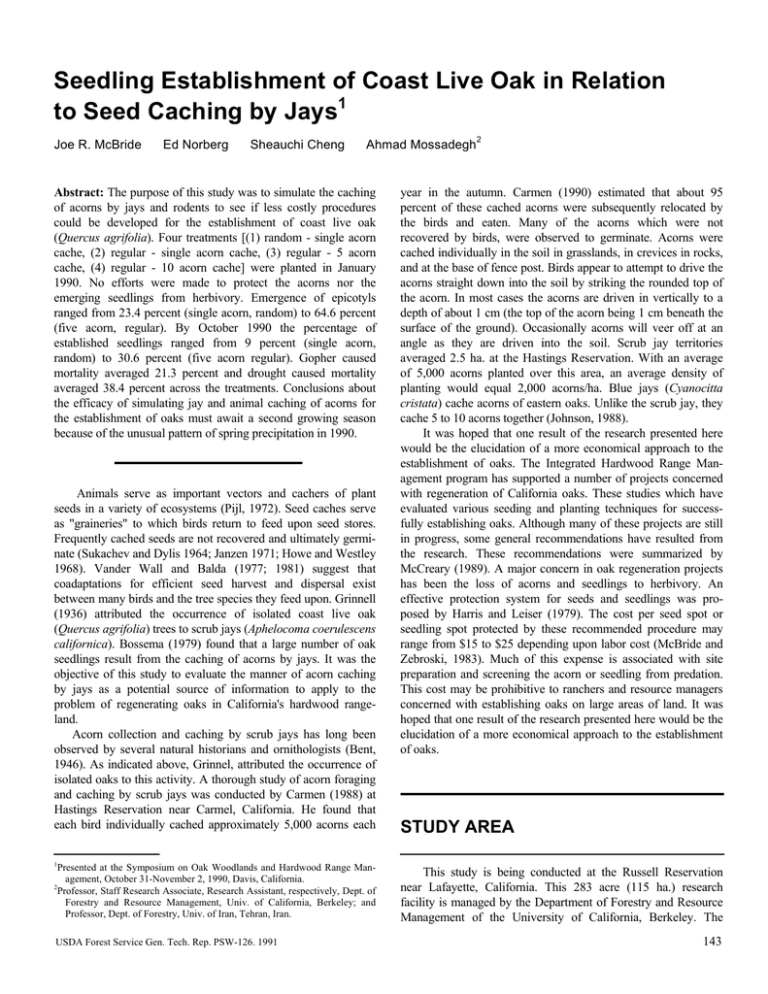Document 11232115
advertisement

Seedling Establishment of Coast Live Oak in Relation to Seed Caching by Jays1 Joe R. McBride Ed Norberg Sheauchi Cheng Ahmad Mossadegh2 Abstract: The purpose of this study was to simulate the caching of acorns by jays and rodents to see if less costly procedures could be developed for the establishment of coast live oak (Quercus agrifolia). Four treatments [(1) random - single acorn cache, (2) regular - single acorn cache, (3) regular - 5 acorn cache, (4) regular - 10 acorn cache] were planted in January 1990. No efforts were made to protect the acorns nor the emerging seedlings from herbivory. Emergence of epicotyls ranged from 23.4 percent (single acorn, random) to 64.6 percent (five acorn, regular). By October 1990 the percentage of established seedlings ranged from 9 percent (single acorn, random) to 30.6 percent (five acorn regular). Gopher caused mortality averaged 21.3 percent and drought caused mortality averaged 38.4 percent across the treatments. Conclusions about the efficacy of simulating jay and animal caching of acorns for the establishment of oaks must await a second growing season because of the unusual pattern of spring precipitation in 1990. Animals serve as important vectors and cachers of plant seeds in a variety of ecosystems (Pijl, 1972). Seed caches serve as "graineries" to which birds return to feed upon seed stores. Frequently cached seeds are not recovered and ultimately germinate (Sukachev and Dylis 1964; Janzen 1971; Howe and Westley 1968). Vander Wall and Balda (1977; 1981) suggest that coadaptations for efficient seed harvest and dispersal exist between many birds and the tree species they feed upon. Grinnell (1936) attributed the occurrence of isolated coast live oak (Quercus agrifolia) trees to scrub jays (Aphelocoma coerulescens californica). Bossema (1979) found that a large number of oak seedlings result from the caching of acorns by jays. It was the objective of this study to evaluate the manner of acorn caching by jays as a potential source of information to apply to the problem of regenerating oaks in California's hardwood rangeland. Acorn collection and caching by scrub jays has long been observed by several natural historians and ornithologists (Bent, 1946). As indicated above, Grinnel, attributed the occurrence of isolated oaks to this activity. A thorough study of acorn foraging and caching by scrub jays was conducted by Carmen (1988) at Hastings Reservation near Carmel, California. He found that each bird individually cached approximately 5,000 acorns each 1 Presented at the Symposium on Oak Woodlands and Hardwood Range Management, October 31-November 2, 1990, Davis, California. 2 Professor, Staff Research Associate, Research Assistant, respectively, Dept. of Forestry and Resource Management, Univ. of California, Berkeley; and Professor, Dept. of Forestry, Univ. of Iran, Tehran, Iran. USDA Forest Service Gen. Tech. Rep. PSW-126. 1991 year in the autumn. Carmen (1990) estimated that about 95 percent of these cached acorns were subsequently relocated by the birds and eaten. Many of the acorns which were not recovered by birds, were observed to germinate. Acorns were cached individually in the soil in grasslands, in crevices in rocks, and at the base of fence post. Birds appear to attempt to drive the acorns straight down into the soil by striking the rounded top of the acorn. In most cases the acorns are driven in vertically to a depth of about 1 cm (the top of the acorn being 1 cm beneath the surface of the ground). Occasionally acorns will veer off at an angle as they are driven into the soil. Scrub jay territories averaged 2.5 ha. at the Hastings Reservation. With an average of 5,000 acorns planted over this area, an average density of planting would equal 2,000 acorns/ha. Blue jays (Cyanocitta cristata) cache acorns of eastern oaks. Unlike the scrub jay, they cache 5 to 10 acorns together (Johnson, 1988). It was hoped that one result of the research presented here would be the elucidation of a more economical approach to the establishment of oaks. The Integrated Hardwood Range Management program has supported a number of projects concerned with regeneration of California oaks. These studies which have evaluated various seeding and planting techniques for successfully establishing oaks. Although many of these projects are still in progress, some general recommendations have resulted from the research. These recommendations were summarized by McCreary (1989). A major concern in oak regeneration projects has been the loss of acorns and seedlings to herbivory. An effective protection system for seeds and seedlings was proposed by Harris and Leiser (1979). The cost per seed spot or seedling spot protected by these recommended procedure may range from $15 to $25 depending upon labor cost (McBride and Zebroski, 1983). Much of this expense is associated with site preparation and screening the acorn or seedling from predation. This cost may be prohibitive to ranchers and resource managers concerned with establishing oaks on large areas of land. It was hoped that one result of the research presented here would be the elucidation of a more economical approach to the establishment of oaks. STUDY AREA This study is being conducted at the Russell Reservation near Lafayette, California. This 283 acre (115 ha.) research facility is managed by the Department of Forestry and Resource Management of the University of California, Berkeley. The 143 Russell Reservation supports a mosaic of annual grassland, coast live oak woodland, northern coastal scrub, chaparral, and various conifer plantations Soils at the Russell Reservation which support annual grasslands and oak woodlands belong to the Los Osos series. Soil profiles in this series are characterized by clay loams to clays below 40 cm. Los Osos soils average about 3 feet (1 m) in depth and are generally developed on fine grained, slightly acidic sandstone. The climate of the study area is classified as Mediterranean type climate. Average annual precipitation amounts to 26 inches (650 mm). Over 80 percent of this precipitation falls during the winter months. Usually no rain falls during June, July, and August. During the year of this study the average January minimum and maximum temperatures were 40.1 °F (4.5°C) and 61.7 °F (16.5 °C) respectively and the average July minimum and maximum temperatures were 55.4°F (13 °C) and 92.3 °F (33.5 °C). Soil temperatures ranged from a January low of 41 °F (5°C) to a July high of 98.6°F (37°C) at a depth of 1 inch (2.5cm). An east facing slope with an angle of repose of 11-12° (2627 pct) was chosen for this study. The California annual grassland type occurred on the slope. Bromus rigidus (ripgut grass) was the dominant species on the slope. Other common species included Avena fatua (wildoat), Rumex acetosella (sheep sorrell), Lolium multiflorum (Italian ryegrass) and Bromus mollis (soft chest). METHODS Four adjacent 10 m by 10 m plots were established and each plot was divided into 25 - 2 m by 2 m subplots. Twenty acorns were planted in each subplots as follows: Treatment #1 (Random-single acorn cache) - each acorn was sown at a random location (the same random pattern was repeated in each 2 m X 2 m subplot in the treatment). Treatment #2 (Regular - Single acorn cache) - each acorn was sown at 20 cm intervals along lines I m apart. Treatment #3 (Regular - 5 acorn cache) - five acorns were sown as a cluster immediately adjacent to one another at 1 meter intervals along lines I m apart. Treatment #4 (Regular - 10 acorn cache) - 10 acorns were sown as a cluster immediately adjacent to one another at 1 meter intervals along lines 2 m apart. To plant the acorns, wooden dipples were made to push holes into the ground for the acorns. It was found, however, that most acorns could be easily pushed into the ground using one's thumb. When more resistant areas of soil were encountered dipples were used. All acorns were planted in a vertical orientation so that the rounded end of each acorn was approximately 1 cm below the surface of the ground. All four treatments were planted on January 4, 1990, 5 days after a 0.7 inch (20 mm) rainfall. This rainfall followed a December drought. Seed spots were not marked in any treatment but the south east corner of each 2 m by 2 m subplot was staked in treatment #1. The uphill 144 and downhill ends of the planting lines in treatments 2, 3, and 4 were also staked. To randomly locate the planting spots in each 2 m by 2 m subplot for treatment #1, four 1 m2 frames were built with wires crossing to mark five random locations in each frame. The random locations were determined by selecting numbers from a table of randoms to be used as X and Y coordinates on each frame. A new set of random numbers were selected for each frame. The numbers chosen (from 1 to 100) were used as distances along "X" and "Y" coordinates on the frames. Wires were stretched from these points and their intersections wrapped with insulated red wire for easy recognition in the field. In the field the four frames (designated A, B, C, and D) were laid on the ground to form each of the twenty-five 2 m by 2 m subplot. A single acorn was planted under each of the five random locations marked by the insulated red wire. The frames were subsequently used to relocate the planting spots to monitor germination, growth, and herbivory. Every four weeks following planting each seed spot was examined for the appearance of the epicotyl above the ground. When epicotyls were present their height was measured. Notes were taken concerning evidence of herbivory and damage to the seedling. Seedling mortality was also recorded. A Foxburo recording thermograph with soil temperature probes was located immediately adjacent to the four treatments. The temperature probes were placed at 1 inch (2.5 cm) and 4 inches (10 cm) below the soil surface. Air temperature was recorded on a Bendix thermograph located approximately 300 feet south of the planting site on the same slope. At this location, maintained as a permanent weather station for the Russell Reservation, precipitation was also measured using a standard 8 inch diameter rain gauge. Soil samples were collected once a month during the study and at times of change in vegetation growth and phenology or unseasonable precipitation for a gravimetric determination of moisture percentage. Approximately 100 grams of soil was taken at 10, 20, 30, 40, 60 and 90 cm in each of the four treatments. Each soil sample was weighed, dried for 24 hours at 105° C, and reweighed to provide data for calculating soil moisture percentage. On June 1, 1990, a point intercept survey was taken to determine the plant species composition of each of the treatment plots. The plant species occurring at 100 points spaced 1 m by 1 m apart across each plot was recorded. At the same time and again on July 26 and October 18, 1990 an estimate of the percentage of the ground covered by soil brought to the surface by pocket gopher activity was made for each plot using the point intercept. Concurrent with the field study, a germination and emergence study was conducted out of doors in Berkeley at temperatures similar to those on the field plots. Two hundred fifty acorns were planted in vermiculite in 20 cm wide by 30 cm deep pots. Germination (defined by the emergence of a radicle from the acorn) was recorded when the pots were harvested. At the end of 100 days, including 10 days without any new epicotyls, all acorns were dug out of the tray to determine the number which had produced radicles but not epicotyls, the number of USDA Forest Service Gen. Tech. Rep. PSW-126. 1991 polyembrionic acorns, and the condition of those which had not germinated. RESULTS AND DISCUSSION The number of current shoots, new shoots, and dead shoots observed each month from March to October 1990 is shown in table 1. An initial period of shoot emergence began in March and continued through June. A second period of shoot emergence began in September, but involved very few seedlings. Shoot emergence ranged from 23.4 percent in the single acorn, random treatment to 64.6 percent in the five acorn, regular treatment (table 2). These percentages were less than the 85.4 percent shoot emergence observed in the pot study conducted in Berkeley. The differences between the field and pot study may have been due to differences in acorn viability, physical resistance of the soil to shoot emergence, and/or seed predation. We believe, that acorn viability was not different because acorns used in both the field and pot studies were taken from the same acorn collection. Furthermore, we started to dig up acorns in the field from sown seed spots which had not produced shoots by the end of May and found all of the acorns (in a 10 pct sample in each treatment) to have germinated. Germination reached 97.5 percent in the pot study (table 3) and we believe a similar Table 1—Summary of oak shoot emergence, mortality, and damage on eight monthly survey date for four acorn cache treatments. Treatment Single Acorn, Random Current Shoots New Shoots Gopher Mortality Drought Mortality Damaged - Living 3-29 Number in shoot status for survey month 4-26 5-24 6-21 7-19 8-23 9-13 10-25 1 1 0 0 0 16 15 0 0 0 85 73 4 0 7 80 10 13 2 10 78 16 15 3 58 56 0 6 18 56 53 1 0 4 51 45 1 8 1 43 Current Shoots New Shoots Gopher Mortality Drought Mortality Damage Mortality 5 5 0 0 0 78 78 2 3 1 159 91 3 7 3 148 13 6 18 8 157 35 9 17 127 114 0 11 32 110 101 0 4 9 96 89 1 8 5 85 Five Acorn, Regular Current Shoots New Shoots Gopher Mortality Drought Mortality Damage Mortality 44 44 0 0 0 164 121 1 0 1 285 125 1 3 10 283 22 9 15 11 253 9 14 25 175 198 0 6 49 187 164 0 18 16 159 153 2 12 1 149 19 19 0 0 0 168 158 0 0 9 240 78 0 5 21 254 21 5 2 10 204 10 9 51 169 150 0 0 54 148 143 0 0 7 137 118 0 8 17 114 Single Acorn, Regular Ten Acorn, Regular Current Shoots New Shoots Gopher Mortality Drought Mortality Damage Mortality Table 2—Total emergence of oak seedlings in four acorn cache treatments Treatment Single acorn, random Single acorn, regular Five acorn, regular Ten acorn, regular Total Emergence *(pct) 23.4 44.6 64.6 57.2 *from January to October, 1990 USDA Forest Service Gen. Tech. Rep. PSW-126. 1991 145 percentage would have been achieved in the field study in the absence of germination. Eighteen point nine (18.9) percent of the acorns which germination in the pot study did not produce an above ground shoot because the epicotyls was trapped by the shell of the acorn. Twelve point one (12.1) percent of the acorns in the pot study produced radicles but no visible epicotyls. We believe that the vertical planting orientation used in both the field and pot study resulted in the trapping of epicotyls within the acorn shell and was in part responsible for the differences in shoot emergence between the field and pot studies. Physical resistance of the soil may have also been a factor in the field. We believe clay loam texture of the A horizon of the Los Osos soil would have offered more resistance to the upward growth of the epicotyl that the vermiculite used in the pot study. The greater shoot emergence in the 5 and 10 acorn treatments may have been in part, due to a collective effort of more than one epicotyl breaking through the soil surface at one time. In April and May it was evident that emerging shoots had lifted the thin layer of surface soil as they had simultaneously emerged from the ground. Seed predation must also account for the differences in shoot emergence between the four field treatments. We believe the lower percentage emergence observed in the single acorn, random cache (23.4 pct) and the single acorn, regular cache (40.6 pct) treatments was to a large part due to acorn consumption by pocket gophers (Thomomys bottae). Point intercept counts of gopher mounds indicated greater gopher activity during the germination period in the single acorn, random treatment plot (table 4). No acorns were found in the 10 percent sample spots excavated (to determine if acorns had germinated) on the single acorn, random treatment plot at the end of May. Griffin (1979) has reported high losses of acorns to predation by pocket gophers in his studies of valley oak (Quercus lobata) seedling establishment in the California coast range. Post emergence shoot survival depended upon herbivory and the capacity of the seedlings to withstand summer drought. Table 5 shows the percentage of seedlings which succumbed to pocket gophers or drought and the percentage of seedlings alive in October which had been damaged by above ground herbivory. A little more than 1/3 of the seedlings (39.3 pct) in the single acorn, random treatment were killed by gophers. This is twice the number killed by pocket gophers in any of the other treatments. We believe the difference in mortality due to gophers is not a function of the treatments, but is related to the distribution of pocket gophers over the study area. More gopher activity occurred, as evidenced by gopher mounds, on the single acorn, random treatment plot. More gopher activity occurred on the single acorn, random treatment plot than on the other plots (table 4). Drought mortality ranged from 23.9 percent in the single acorn, random treatment to 55.2 percent on the 10 acorn treatment. Greater drought mortality in the 10 acorn treatment may be due to competition for soil moisture among the oak seedling. However, a relatively low level (33.7 pct) of drought mortality was observed in the five acorn treatment. The drought mortality observed in this study may be less than one would see in a more typical rainfall year. An unusually heavy rain (69 nun) occurred 146 Table 3—Summary of germination and epicotyl emergence of 280 acorns sown in pots after 100 days. Acorns that grew a radicle (germinants) Germinants that grew epicotyl (Polyembryony) Germinants with an emergent epicotyl (Polyembryony) *Germinants with non-emergent epicotyl (Polyembryony) *Germinants without visible epicotyl formation Number Percent 273 239 (18) 186 (11) 53 (9) 97.5 85.4 (6.4) 66.4 3.9 18.9 3.2 34 12.1 7 2.5 *Non-Germinants *Acorn and any growth was completely or partially rotted at harvest. Table 4—Percentage of ground covered by soil excavated by pocket gophers on the four acorn cache plots as measure of pocket gopher activity Single Acorn Cache Random Regular Multiple Acorn Cache (regular) Five Ten June 1 7 1 0 1 July 26 32* 7 10 1 Oct. 18 14 7 12 8 *Note: Some unknown part of the increase was probably due to the gopher responses to the late May rains and the cleaning out of old tunnels thus spreading the soil over a wider area during early June but still is an indication of gopher movement. in May, 1990. The average precipitation in May is 5 mm at the Russell Reservation. The heavy May, 1990 rain brought soil moisture levels back up to the levels observed in February and March in the upper 30 cm of the soil profile (table 6). This added soil moisture, at a time when the annual grasses had senesced, provided the oak seedlings with a typical summer soil moisture. In response to this moisture, new shoots emerged and shoot growth was resumed. Herbivory was observed on shoots of nearly all seedlings in all treatments (table 5). Herbivory by insects, mice or other small mammals, and deer occurred on the plots. We believe that deer accounted for a relatively small percentage of the herbivory observed because only small amounts of shoots and foliage was removed by herbivores from most seedlings. Deer and rabbit droppings and mouse burrows were observed on the plots. Grasshoppers, earwigs, and unidentified insect larvae were also found on the plots. It is also possible that pocket gophers may have fed on the above ground portions of seedlings. USDA Forest Service Gen. Tech. Rep. PSW-126. 1991 Table 5—Percentage of oak seedlings killed by gophers or drought and percentage of above ground seedling alive in October, 1990 showing evidence of herbivory. Treatment Gopher Mortality (pct) Drought Mortality (pct) Live Seedling showing Herbivory (pct) Single acorn, random 39.3 23.9 95.6 Single acorn, regular 19.3 40.8 95.5 Five acorn, regular 18.9 33.7 97.4 7.7 55.2 96.7 10 acorn, regular Table 6—Soil moisture percent on Acorn Cache Plots (± 1.5 pct) for relevant tripicate soil samples Depth cm 10 20 30 40 60 90 Feb. 20 March 20 28 25 25 28 28 30 18 24 25 27 28 30 April 12 11 12 15 20 24 28 May 10 10 11 14 17 22 24 June 1 23 23 21 17 20 23 June 28 July 18 19 20 18 17 20 21 12 15 15 15 18 21 Note: Feb. 20 to April 12 - Period of grass growth from coleoptile stage to 18" to 24" April 12 to June 1 - Maturation of grass and increased soil moisture withdrawal that is concurrent with seed production. Late May rainfall occurred after death of grass and oak seedling drought stress. June to July 18 - Period of soil moisture recharge down to 40 cm. Some oaks resumed shoot growth and a few grassed germinated from this year's seed. Some acorns held back by prior low soil moisture produced an aerial epicotyls. CONCLUSIONS The expected results of this experiment have been somewhat clouded by unequal levels of acorn predation and seedling consumption by pocket gophers among the treatments. Interpretation of the results is further complicated by the unusual rainfall year. In spite of these complications, the study does demonstrate that coast live oak acorns can be sown to simulate the caching of acorns by scrub jays and seedlings will emerge and survive. More emergence could be expected if a horizontal orientation of the acorn was used (McCreary, 1989). That of course is not in the best interest of the jay, whose caching technique have evolved to minimize early emergence of the epicotyl and save as much storage material as possible for the jay. We plan to continue monitoring seedling growth and survival in this study to record the response of the treatments over a five year period. If the survival rate after one growing season is maintained, we believe we will have demonstrated a cost effective alternative to establishment procedures currently recUSDA Forest Service Gen. Tech. Rep. PSW-126. 1991 ommended for California oaks. The sowing cost in our study amounted to $0.01 per acorn. At this price one could afford 35 to 77 percent mortality rates we observed and still regenerate coast live oak at a cost of about $5.00 per acre. REFERENCES Bent, A.C. 1946. Life histories of North American jays, crows, and titmice. Bulletin No. 191. Washington, D.C.: United States National Museum. Bossema, 1. 1979. Jays and oaks: an eco-ethological study of a symbiosis. Behavior 70:1-117. Carmen, W.J. 1988. Behavioral ecology of the California scrub jay (Aphelocoma coerulescens Californica): a non-cooperative breeder with close cooperative relatives. Ph.D. Dissertation. Berkeley: University of California Press; 334 p. Carmen, W.J. 1990. Personal communication. Griffin, J.R. 1979. Animal damage to valley oak acorns and seedlings, Carmel Valley, California. Proc. of the Symposium on the Ecology, Management, and Utilization of California Oaks. PSW-44. Berkeley, California: Pacific Southwest Forest and Range Experiment Station, Forest Service, U.S. 147 Department of Agriculture; 242-245. Grinnell, J. 1936. Uphill planters. The Condor 38:80-82. Hams, R.W.; Leiser, A.T. 1979. Direct seeding woody plants in the landscape. Leaflet 2577. Berkeley: University of California. Division of Agricultural Science. Howe, H.F.; Westley, L.C. 1968. Ecology of pollination and seed dispersal. In: M.J. Crowley (ed.) Plant ecology. Oxford: Blackwell Scientific Publications; 185-215. Janzen, D.H. 1971. Seed predation by animals. Annual Review of Ecology and Systematics 2:465-492. Johnson, C.W. 1988. Acorn caching by the blue jay. Personal communication. McBride, J.R.; Zebroski, O. 1983. Vegetation management plan - phase I Stanford University. Berkeley, California: Haygood and Zebroski Landscape Architects; 61 p. 148 McCreary, D.D. 1989. Regenerating native oaks in California. California Agriculture 43(1):4-6. Pijl, L. van der. 1972. Principles of dispersal in higher plants. New York: Springer-Verlag; 162 p. Sukachev, V.N.; Dylis, N.V. 1964. Fundamentals of Forest Beogeocoenology. Translated by J.M. MacLennan. Oliver and Boyd, Ltd., Edinburgh; 672 p. Vander Wall, S.B.; Balda, R.P. 1977. Coadaptations of the Clark's nutcracker and the pinon pine efficient seed harvest and dispersal. Ecological Monographs 47:89-111. Vander Wall, S.B.; Balda, R.P. 1981. Ecology and evolution of food-storage behavior in conifer seed-caching Corvids. Zeitschriftfur Tierpsychologie. 56:217-242. USDA Forest Service Gen. Tech. Rep. PSW-126. 1991








